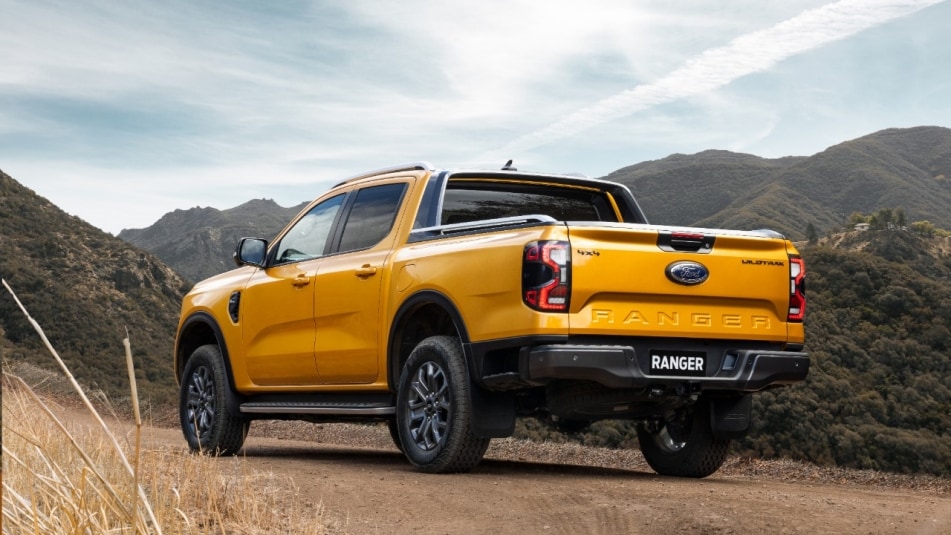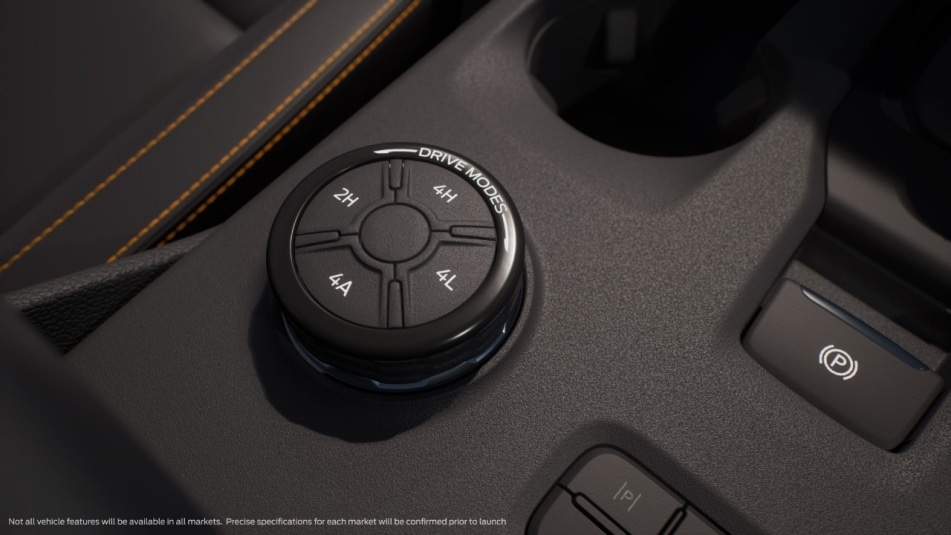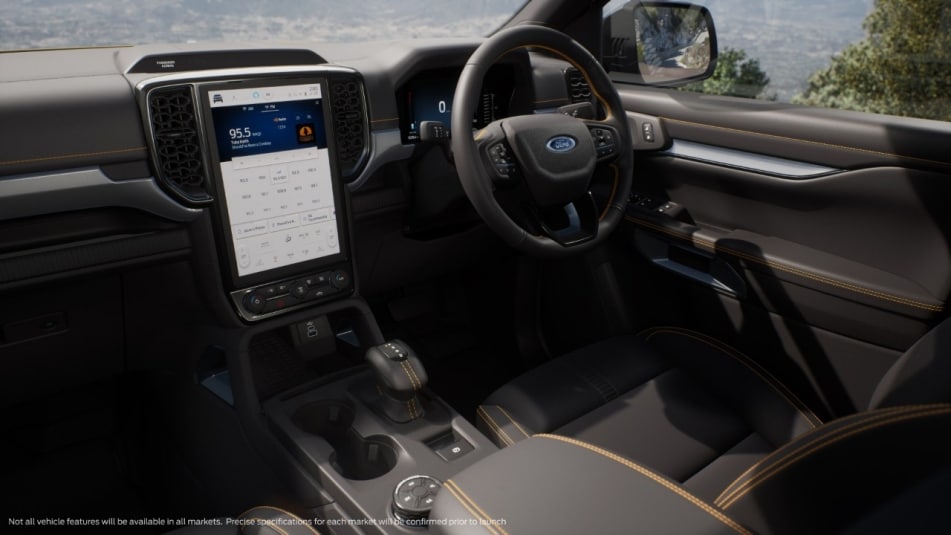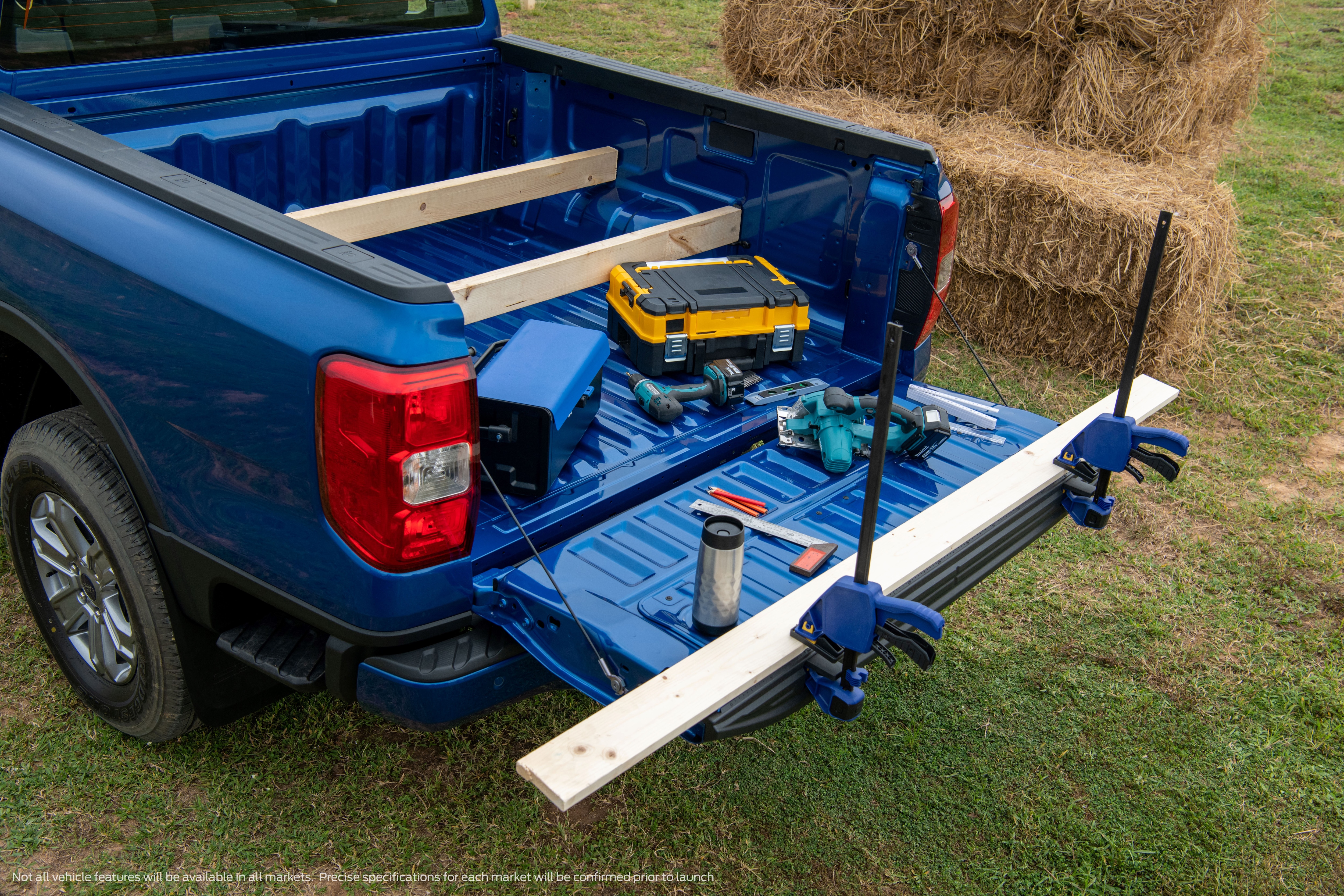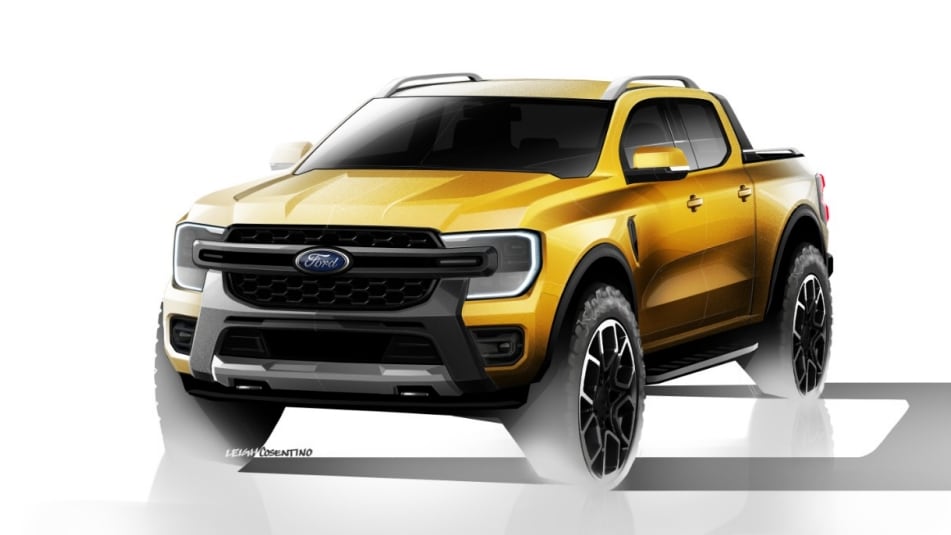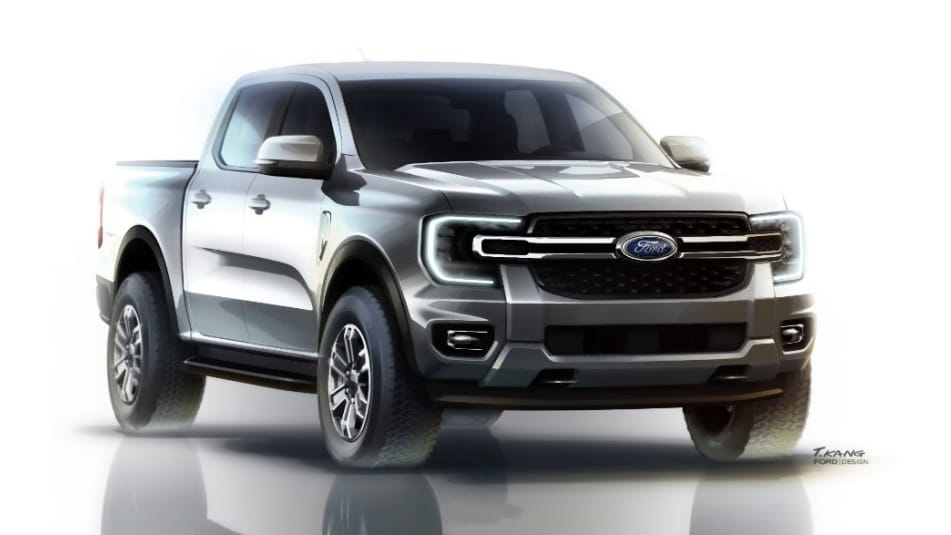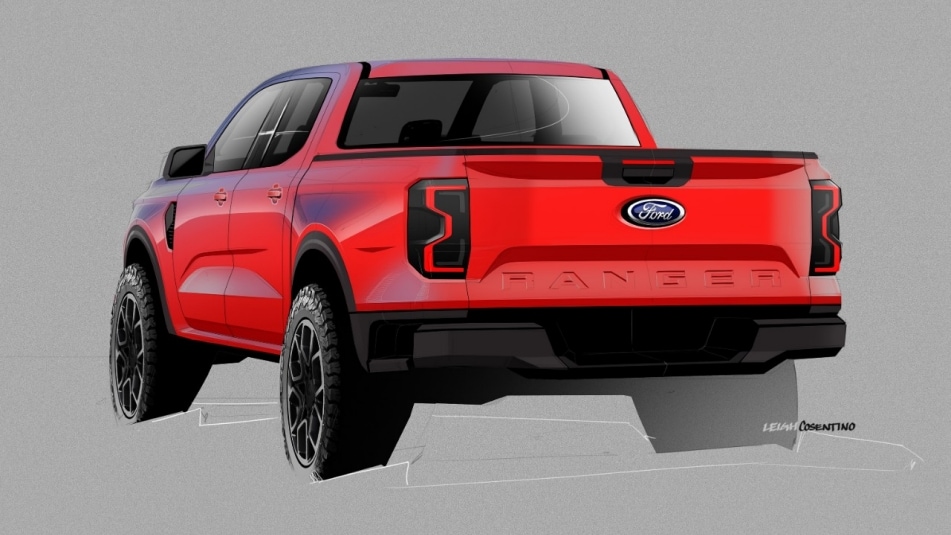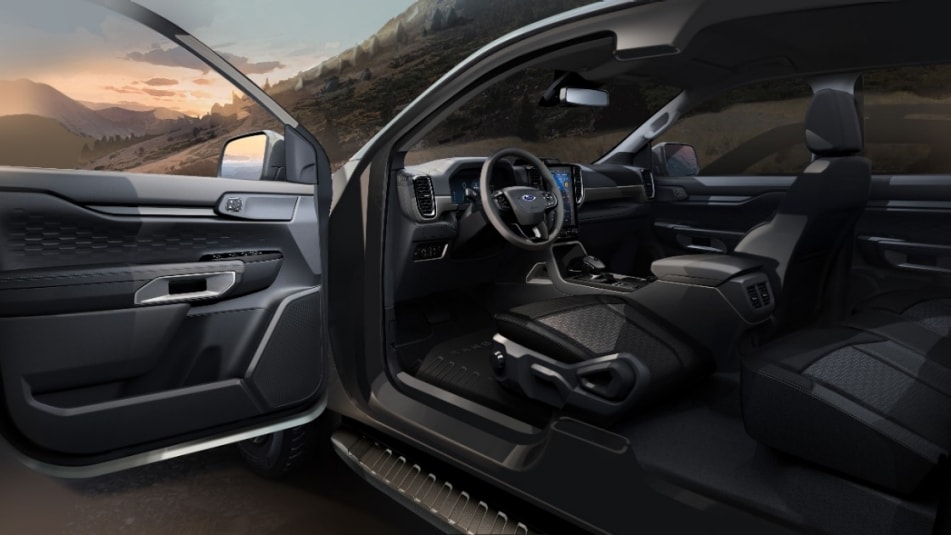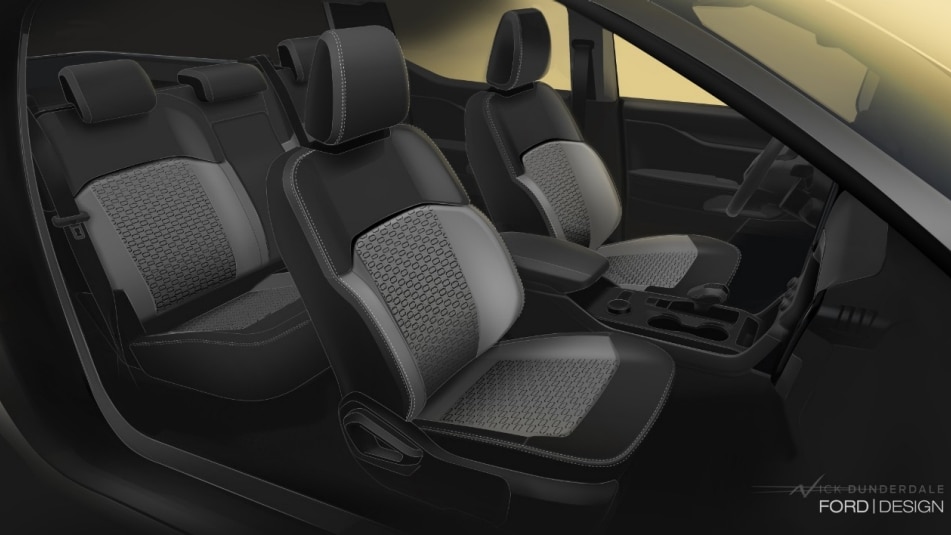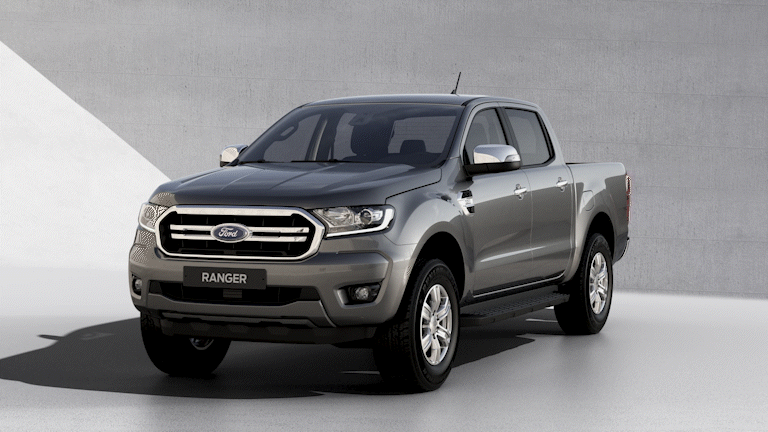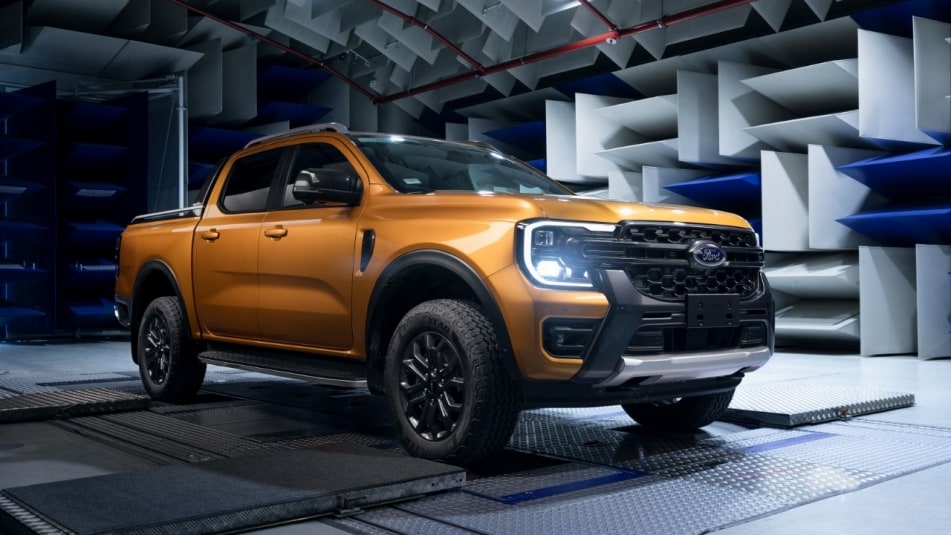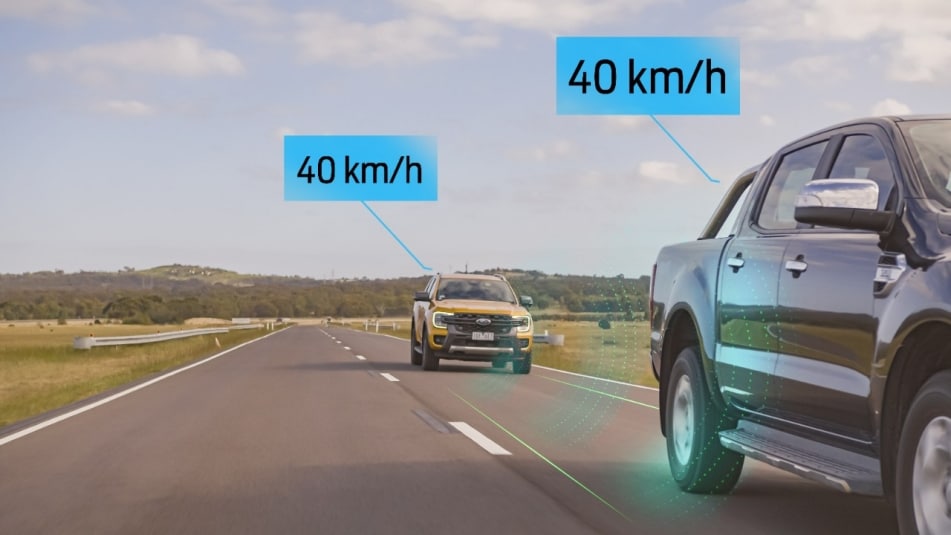Next-Gen Ranger
Overview
Next-Generation Ford Ranger Delivers High-Tech Features, Smart Connectivity, Enhanced Capability and Versatility for Work, Family and Play
- Ford engineers and designers teamed up with customers around the world to create a pickup they can rely on for work, family and play
- With rich input from customers, designers created a bold, purposeful exterior design and sleek, high-tech, inviting interior
- Depending on the market, the next-gen Ranger offers a choice of proven and durable petrol and diesel powertrains, including the addition of Ford’s powerful V6 turbodiesel and 10-speed transmission
- An upgraded chassis and suspension ensure excellent ride and handling, whether riding with passengers, fully loaded with cargo or towing
- Cargo area built to help customers do more, with increased functionality and better access
- Ford also outlined its “always-on” commitment to customers, with a host of services centered around convenience on their terms
MELBOURNE, Australia, November 24, 2021 – Ford today put the global pickup world on notice by revealing the smartest, most versatile and most capable Ranger ever – delivering an even more desirable pickup partner for customers.
Using years of Ford truck expertise and deep understanding of truck customers, the company collaborated with customers around the globe to create a vehicle and ownership experience that next-gen Ranger owners can rely on for their businesses, family lives and adventure.
“With Ranger, we’ve had a big extended family for decades,” said Jim Farley, president and CEO. “This truck has always been a trusted partner to small business owners, farmers, families, adventurers, commercial fleets and so many more in more than 180 markets around the world. And with the new Ranger, this is our moment to deliver. Not just a product our customers will love, but an always-on experience that will help us build strong and lasting relationships with them. This is the midsize truck people will want to own and experience.”
In addition to revealing the next-generation Ranger, Ford also outlined its “always-on” commitment to customers, with a host of services centered around convenience on their terms. Depending on market, these include service pickup and delivery, a Ranger Concierge program, and streamlined online service booking options, to name a few.[i]
“When we reimagined the Ranger, we set out to create more than just a great new pickup truck; we set out to design a great experience as well,” said Dianne Craig, president of Ford’s International Markets Group. “We are a family company, and we want our customers to feel like part of our family. The vehicle sale is just the beginning of our journey together.”
Living the Ranger Life
“We’ve really packed a lot into the next-generation Ranger to inspire owners to do more of what they love to do, with features that encourage them to explore new horizons,” said Gary Boes, Enterprise Product Line Management director, Global Trucks.
Ford calls this “Living the Ranger Life,” and it’s something shared by every designer and engineer involved in creating the next-generation Ranger.
“We’re truck owners too, and this passion for the Ranger lifestyle translates into a passion for the product,” Boes added. “Ultimately, we want our customers’ experience with the pickup to enable and enhance their lifestyles.”
The next-gen Ranger project was led by Ford’s Product Development Center in Australia. Its international team of dedicated designers and engineers worked with teams around the globe to not only incorporate the very latest in Ford technology, capability and safety, but to also engineer and test the Ranger to Ford’s toughest standards.
“Our team was focused on one goal – to make this Ranger the toughest and most capable we’ve ever created,” said Graham Pearson, Ranger vehicle program director. “They put it through one of the most exhaustive global testing schedules we’ve ever developed and would not rest until we were satisfied that it was Built Ford Tough.”
New Look, New Capabilities
DISCLAIMERS
i Not all services will be available in all markets. Precise services available for each market will be confirmed prior to launch.
ii Not all vehicle features will be available in all markets. Precise specifications for each market will be confirmed prior to launch.
iii Use of FordPass™ App is subject to the FordPass Terms and Privacy Policy and requires a compatible mobile device, internet access and software (including software updates from time to time). You are responsible for internet access, mobile network data and voice call services required for your use of the FordPass App on your mobile device, including associated fees. The FordPass App and the FordPass™ Connect modem can only work when both are connected to the telecommunications network. Ford cannot guarantee FordPass will be fully operational at all times and the App may be unavailable or particular services interrupted. Ford is not responsible for any limitations of the telecommunications network or your mobile device.
iv Not all SYNC® 4 features are compatible with all phones
Design Overview
Customers Helped Create Athletic, Bold and Distinctively Styled Next-Generation Ford Ranger Design
DISCLAIMER
i Not all vehicle features will be available in all markets. Precise specifications for each market will be confirmed prior to launch.
Product information
More Capability to the People: Next-Gen Ford Ranger Takes Power, On- and Off-Road Capabilities to the Next Level
Next-gen Ford Ranger Delivers More Confidence Than Ever, Thanks To Advanced Safety Features And New Driver Assistance Technologies
Next-Gen Ford Ranger Pushes the Boundaries of a Smart Mid-size Pickup Thanks to its Customer-Focused Connectivity and Technology
Segment-defining Smarts
Next-gen Ranger integrates Ford’s latest connectivity and driving technologies for a seamless connected experience whether customers are using their truck for work, family or play.
An 8-inch colour, reconfigurable, digital instrument panel allows more information to be presented to the driver than an analog system. Additionally, the large-format, 10.1- or 12-inch infotainment screens, featuring Ford’s cutting-edge SYNC 4A communication and entertainment system, have helped declutter the dashboard.
Ranger’s first-in-class e-shifter and electric parking brake bring a more techy feel to the interior and allow greater accessibility and space to drivers.
The next-gen Ranger also takes lighting to the next level with full LED lighting for both front and rear, including available first-in-class Matrix LED headlights and zone lighting.
The FordPass™ii app enables owners to use their smartphone to organise things like service scheduling, remote start, vehicle location, vehicle health alerts, remote locking or unlocking, and activating the heating or cooling to the previously set temperature.
KEY RANGER TECHNOLOGY FEATURES iii
Digital Display
Next-gen Ranger has done away with a physical instrument cluster for things like the speedometer, replacing them with an 8-inch digital instrument panel that can be customised. These displays boast a start-up and farewell animation and a digital speedometer and tachometer. The graphics also feature realistic body-style avatars.
Depending on the variant, owners can toggle between layouts showing information such as driver-assist technologies, tachometer on or off and extra gauges. There’s also a ‘calm view’, which removes information on demand from the display.
Because next-gen Ranger features on- and off-road driving modes, the instrument panel displays a different theme for each selected drive mode, with animated mode changes when the driver scrolls from one to the other.
Smarter, Intuitive Connectivity with SYNC 4Aiii
At the heart of next-gen Ranger’s technology story is the SYNC 4A communications and entertainment system. This system offers wireless Apple CarPlay™ and Android Auto™ smartphone connectivity and displays the latest features used to make the SYNC 4A system easier to navigate. If the customer has cellular coverage, SYNC 4A can provide real-time informationiv like fuel pricing, traffic alerts and more.
Big Screen
Whether the next-gen Ranger is equipped with a 10.1- or a best-in-class12-inch infotainment screen, there’s a customisable split-screen setup with an information-on-demand panel always available at the bottom of the screen. This displays key information, like native or connected navigation iv, the user’s connected smartphone and more.
The team chose a large-format tablet screen because it allowed for a good depiction of navigation while still leaving room at the bottom of the screen for things such as climate and entertainment controls.
Ford Power-Up Updates
The next-gen Ranger also will be fitted with an embedded factory-fitted modem allowing connectivity on the go when linked with the FordPass App, so customers can stay connected to their truck. Ranger also is designed to evolve over time. In the future, customers will be able to secure Ford Power-Up updates, which offer enhancements from updating the SYNC 4A software, to upgrades that improve the vehicle’s quality, capability and convenience without the need to schedule a service.
Fewer Buttons, More Capability
Many of the traditional driving mode controls have been moved from the dash and centre console to their own dedicated display on the SYNC screen.
For example, with one button press, drivers can go to Ranger’s dedicated off-road screen where they can monitor the driveline, steering angle, vehicle pitch, roll angles and other controls.
The cabin climate and entertainment can be controlled via the SYNC screen, with additional physical controls mounted just below the screen for quick and easy adjustments.
Look All Around
The screen is linked to a 360-degree camera to make parking a breeze in tight urban spaces or to assist when negotiating particularly tricky terrain while out exploring. The system allows the driver to see what’s in front of or behind the vehicle as well as a top-down view of the area around the vehicle, including blind spots, for added confidence.
Change Gear
The team fitted the higher variants of next-gen Ranger with a first-in-class, short-throw e-shifter and electric parking brake for a more high-tech feel. This change not only allows for greater accessibility for drivers, but also provides the opportunity for increased advanced driver assist systems (ADAS)v, like fully automated parking assist.
Keep It Charged
Next-gen Ranger now allows customers to keep their smartphone wirelessly charged and connected to SYNC 4A via a charging pad at the base of the centre console. Smartphones also can be charged via a cable to a USB port or with the available 12V/240V sockets and the 400W inverteriii that bring power to the box.
Power Up High
With more and more drivers using dash cams, the team installed a high-mounted USB outlet alongside the rearview mirror. This Type-A USB outlet converts 12V power into 5V USB output and is designed to power an external GPS or dash camera. It also can be used to charge a smartphone, although this outlet isn’t connected to the SYNC 4A system.
Let There Be Light
Next-gen Ranger’s model-dependent segment-first Matrix LED headlights boast a raft of clever features, including auto dynamic levelling and speed dependent lighting that can adjust the intensity of the beam in front of the vehicle depending on the speed at which you’re travelling. The headlights also offer both static and dynamic bending capability as well as glare-free high-beams, which help block light that could otherwise temporarily blind other drivers and cyclists.
Another segment-first feature for Ranger is the new exterior zone lighting system, which can be controlled via the SYNC 4A screen or the FordPass app on smartphones. This zone lighting consists of headlights, puddle lamps, numberplate lights and cargo box lights. These lights can be controlled as a ‘zone’ or altogether, which means owners don’t have to work, camp or do anything in the dark.
In the Palm of Your Hand
The FordPass app helps connect Ranger owners with their new truck more than ever. It allows them to remotely check all sorts of things on their next-gen Ranger like the fuel level, odometer, vehicle location and more. It can also be used to activate the zone lighting, remotely lock or unlock the vehicle, and even remote start to pre-condition the vehicle’s cabin on a hot day or warm it up and defrost the windscreen on a cold winter’s day, activating the heating or cooling to previously set temperatures. For peace of mind, during a remote start, the Ranger remains locked and cannot be driven away without a valid key being detected.
Premium Sound
The B&O®vi sound system in the next-gen Ranger went through rigorous static and dynamic acoustic testing. The size and placement of the 10-speakers was purpose-designed and specifically placed to fill the cabin with rich, emotional audio and maintain both power and clarity even over the roughest terrain. The speaker grilles boast the iconic B&O radiating hole design blending beautifully with the rest of the Ranger’s interior. The 660-watt amplifier and the enveloping soundstage, created by 10 speakers, are balanced by intelligent digital signal processing for a total sound experience, ensuring you never hear just a single speaker.
Keep Your Cool
Next-gen Ranger also features a new climate control system with a compressor featuring variable-stroke technology. This technology improves refinement through reduced compressor cycling and reduced engine load resulting in fuel efficiency gains. Owners will be able to access the climate controls via SYNC 4A or hard buttons at the base of the screen. A new sensor is able to measure cabin temperature and humidity to quickly adjust modes and blower speeds to maintain a comfortable cabin in all weather conditions. For the first time on Ranger, rear console-mounted registers are available for automatic and manual systems, improving cabin comfort for those in the back seats.
Quotes
“We’ve not only made the next-gen Ranger smarter, but we’ve enhanced the user experience. Whether it’s being able to control certain vehicle features from your smartphone via the FordPass™ii app, or the inclusion of new-generation infotainment, we’ve improved the interface between driver and vehicle.”
Chris Clarke, connectivity applications supervisor
“The new SYNC®i 4A screens are a huge change for Ranger, and the addition of the latest-generation SYNC 4A system delivers the sort of experience that customers expect from their smartphones. It’s got more computing power and better machine learning, and it’s more intuitive for users. More than that, we’ve been able to declutter the dashboard and make accessing vehicle settings both easier and quicker.”
George Christopoulos, SYNC application engineer
Notes and disclaimers
i Not all SYNC® 4A features are compatible with all phones
ii Use of FordPass™ is subject to the FordPass Terms and Privacy Policy and requires a compatible mobile device, internet access and software (including software updates from time to time). You are responsible for internet access, mobile network data and voice call services required for your use of the FordPass App on your mobile device, including associated fees. The FordPass App and the FordPass™ Connect modem can only work when both are connected to the telecommunications network. Ford cannot guarantee FordPass will be fully operational at all times and the app may be unavailable or particular services interrupted. Ford is not responsible for any limitations of the telecommunications network or your mobile device.
iii Not all vehicle features will be available in all markets. Precise specifications for each market will be confirmed prior to launch.
iv Connected built-in navigation is offered with a 1 year of complimentary service. Precise local market offerings will be shared at launch.
v Driver-assist features are supplemental and do not replace the driver’s attention, judgement, and the need to control the vehicle. Automatic emergency braking detects pedestrians, but not in all conditions, and can help avoid or reduce a collision.
vi BANG & OLUFSEN© 2022 and B&O© 2022. BANG & OLUFSEN™ and B&O™ are registered trademarks of Bang & Olufsen Group. Licensed by Harman Becker Automotive Systems Manufacturing Kft. All rights reserved.
NEXT-GEN RANGER DELIVERS THE VERSATILITY EVERY TRUCK CUSTOMER NEEDS
Redefining Versatility
Next-gen Ranger offers an array of organisation and storage solutions to secure cargo, make fitting accessories a cinch and even DIY customisation. For instance, owners can create segmented DIY storage spaces, both big and small, by sliding pieces of wood into slots moulded into the bedliner, or even get creative and build things like a bike rack.
There are tie-downs mounted in the bed, sliding cleats that can be adjusted into nine positions to help secure odd-shaped cargo, while external tie-down rails make securing bulky loads easier. And the new rear load box access step is the result of more than 5000 interviews with pickup owners, learning how they used their trucks and what they wanted from their next one.
For those who use their vehicle for adventure, the addition of six structural attachment points in the protective load box capping, make it easy to fit accessories like a canopy, cross bars or a tent, truly making next-gen Ranger the most versatile ever.
There’s now more storage space on the inside of next-gen Ranger too, from under-seat storage to retractable cup holders and a raft of cubby holes stashed around the cabin. There’s room under the bonnet for a second battery, and the vehicle has been pre-wired with auxiliary switches, making it easier to install accessories like driving lights, a winch and more.
Notable Examples
The Cargo Box - Versatility as a Workspace
Ford’s design team studied the ways customers used the cargo box – be they a tradesman, adventurer or family who needed to carry ‘stuff’ – and developed many innovative ways to help them access and use the space more effectively.
• The rear load box access step makes climbing up into the cargo box much easier. Attached directly to the load box via two steel supports, the box step boasts a strong, durable construction and means you no longer need to climb onto the wheel to access gear, tools or equipment in the back of Ranger.
• Load box lighting means that setting up or packing camp sites or finding gear in the dark is a lot easier.
• Zone lighting can be controlled via the infotainment system inside the vehicle or via the FordPass™ app on your smartphone. A combination of the headlights, puddle lamps, numberplate lamps and box lighting can be set to illuminate a 360-degree area around the truck, or in specific areas. It is perfect for safely inspecting the area around the vehicle at night.[i]
• The easy-lift tailgate, which can be raised and lowered with one hand, doubles as a mobile workbench. The tailgate work surface is designed to help owners with professional or DIY jobs. Two clamp pockets concealed by spring-loaded caps in the tail gate are designed to help secure timber or other project materials, while a built-in ruler with 10mm increments (on models not fitted with a drop-in bedliner) makes measuring convenient.
• Power to the box comes in the form of a combination of either 400W and 12V sockets or just one or the other, meaning customers can power a range of appliances by plugging directly into the Ranger. With a 400W capacity, items including a small oven, smartphone or laptop, a rice cooker and even a 24-inch LED TV and DVD combination and many more can all be run from the bed-mounted 400W outlet.
The Cargo Box - Innovations for Load Carrying
The next-gen Ranger’s cargo box includes several new innovations that help customers customise the load area to suit their needs.
• The new drop-in bedliner incorporates functional divider locators so that owners can create their own compartments to store gear that they might otherwise have to carry in the cabin. Dividers can be custom-made from timber at home and then installed and removed as required. As a bonus, the improved and wider moulded profile on the bedliner is more comfortable on your knees, is much easier to clean and also means items are less likely to slip around.
• Loading and unloading the Ranger has never been easier. At 1,233-litres, the cargo box has best-in-class volume*, meaning customers can carry more. With Ranger now 50mm wider, the cargo box can accommodate a standard European pallet between the wheel arches (up to 1,224mm) while the loadbox length runs from 1,544mm to 2,305mm depending on the variant. [ii]
• An internal rail with spring-loaded, adjustable cleats on either side of the cargo box allows customers to configure their cleats and tie-downs to suit every load. Cleats slide and lock into nine locations along the rail. There are also six fixed tie-down points in the cargo box.
• External tie-down rails create ultimate cargo hauling flexibility and are designed to easily fit ratchet straps and ropes, while Wildtrak models are fitted with aluminium extrusions that double as tie-down rails that run the full length of the cargo box.
• Durable plastic box top and tail gate capping protects the load box edges and tailgate upper edge from damage. That means owners can load equipment into the cargo box without fear of damaging the paint on the top surface of the load box or tail gate.
• Load box access caps are removable plastic caps that cover structural attachment points for aftermarket accessories like canopies and equipment crossbars for camping and adventure gear.
• Roof top platform mounts allow for the easy fitment of roof accessories, like racks or a platform. Next-gen Ranger’s roof load limits are up to 350kg (static) and 85kg (dynamic).
• The available powered roller shutter allows customers to open and close the box cover using their key fob or from a switch inside the cargo box or from the instrument panel. Special accessories channels run down the sides of the roller shutter allowing customers to easily fit accessory mounts for things like bikes, snow boards/skis, kayaks or camping gear. The powered roller shutter boasts features including an ice breaker and anti-pinch, which automatically stops the shutter when it detects an obstruction.
Versatility Inside, Too
Ford designers have redesigned the interior of the next-gen Ranger to help customers keep their vehicle organized. More storage space inside and the new centre console design with dedicated storage compartments means owners can keep their next-gen Ranger more organised than ever before.
• A redesign of the under-seat storage has created more room in the bins underneath the rear seats allowing for the ‘over-filling’ of the bins while still allowing the seats to be dropped in place.
• The rear seat back also folds perfectly flat, allowing you to carry more gear inside.
Extra Versatility
Customers can personalise their next-gen Ranger with a range of as many as 600 factory-backed work, urban and adventure accessories, depending on the market. These accessories include those developed in collaboration with global off-road icon, ARB 4x4 Accessories. The ARB 4x4 Accessories and Ford collaboration will initially roll out in select markets.
For customers who want the ability to operate electrical accessories easily from the inside of the cabin, the new Ranger offers a pre-wired auxiliary switch bank. This allows customers to safely and easily add accessories such as light bars, work lights, warning beacons, loudspeakers and other electrical equipment to their vehicle.
And for those owners looking to make their next-gen Ranger adventure ready, the team made sure to create a space in the engine bay for a dual battery setup. This kit will enable new owners to add an auxiliary battery to power their fridges, lighting, tools and other electrical gadgets without draining their main battery.
Quotes
“We’ve really packed a lot into the next-generation Ranger to inspire owners to do more of what they love to do, with features that encourage them to explore new horizons.”
Gary Boes, Enterprise Product Line Management director, Global Trucks
“My job is to think like our customers and integrate the features that deliver what they need. In fact, that’s the most rewarding part of my job – talking to owners, learning their requirements, engineering a solution, and then making it real. And regardless of whether our customers are do-it-yourselfers, small business owners or avid overlanders, they all rely on a cargo area that is functional, convenient, and durable.”
Anthony Hall, vehicle engineering manager
“Before we started the design process, we took all of the research and boiled that down into some key phrases or themes to begin our work. One of those themes was 'empowering mastery'. This, to us, simply meant that we needed to deliver a product that would enable customers to be the best they could be – whether at work or play, or with their families. We were focused on authenticity and delivering a truck that wasn't superfluous, meaning everything in it had a purpose and meaning.”
Leigh Consentino, Ranger exterior design manager
Notes and disclaimers
[i] Not all vehicle features will be available in all markets. Precise specifications for each market will be confirmed prior to launch.
[ii] Use of FordPass™ App is subject to the FordPass Terms and Privacy Policy and requires a compatible mobile device, internet access and software (including software updates from time to time). You are responsible for internet access, mobile network data and voice call services required for your use of the FordPass App on your mobile device, including associated fees. The FordPass App and the FordPass™ Connect modem can only work when both are connected to the telecommunications network. Ford cannot guarantee FordPass will be fully operational at all times and the App may be unavailable or particular services interrupted. Ford is not responsible for any limitations of the telecommunications network or your mobile device.
[iii] When not equipped with drop-in bedliner.
* Mid-size pickup category.



